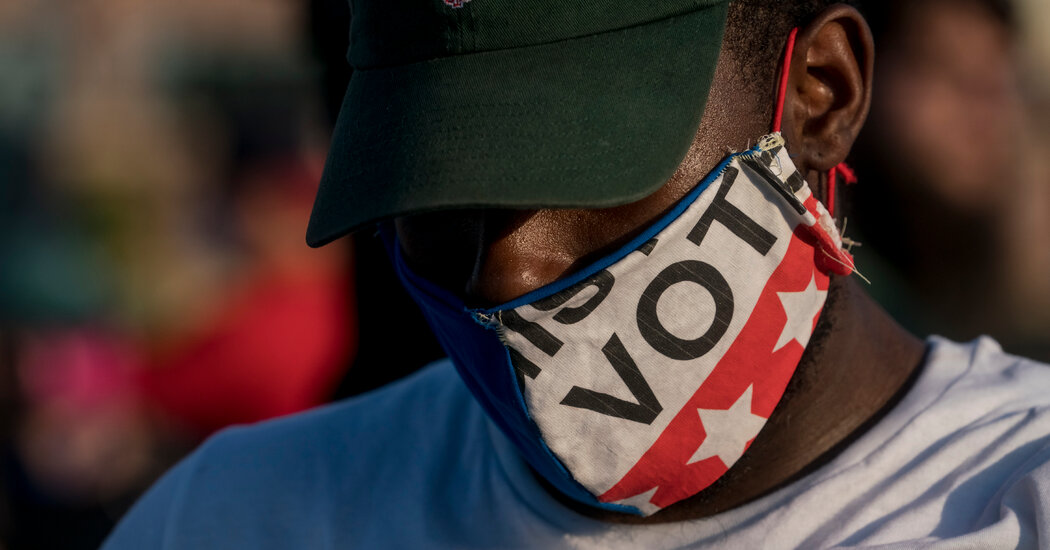In the nationwide protests after the killing of George Floyd in police custody, Democratic leaders held out hope that the sweeping calls for racial justice and structural change would have a decidedly conventional side effect: more people would be motivated to vote in the fall. Activists holding voter registration clipboards became commonplace at protests.
Now, new voter registration data shows that a surge in sign-ups driven by the protests may have indeed rippled across the electorate.
In the first half of June, a month when, during an election year, voter registration normally suffers from a summer lull, more than 520,000 Democrats registered to vote. That’s a nearly 50 percent increase over the previous month’s total and a rate that outpaced Republicans in nearly every state during those two weeks, according to data compiled by TargetSmart, a Democratic data firm.
Some states, like Wisconsin, still had not reported their registration statistics for June at the time the report was released, meaning the increase is probably larger.
Republican voter registration in the same time period increased just 6 percent, to 304,000.
The surge was momentary and did not universally change the overall dynamics of voter registration in 2020 — by the end of the month, Republicans had caught up in many red states and some swing states, and the registration numbers for both parties are still well below 2016 levels. And there may have been other factors at work than the protests: Early June brought an easing of pandemic-related restrictions around the country, such as the reopening of election offices and motor vehicle commissions, which most likely made it easier to register to vote.
Still, the sheer size of the increase during such a specific time — early June — makes it likely that the protests played a significant part in the surge. And however short it lasted, it gives hope to Democrats that they can convert the energy in the streets into votes this fall.
Every state that provided data experienced a boost in registration beginning the first week of June, according to TargetSmart. That was the same week protests began gripping the country in earnest. In Michigan, registration tripled in the first week of June. In Minnesota, the epicenter of the protests, registration more than tripled that week. In Colorado, registration increased by more than 200 percent in the first week of June. In California, voter registration doubled during the protests.
Voter-registration activists understood that the opportunity and energy could be fleeting, and turned out in force to take advantage.
“Historically successful protests movements, ones that have resulted in policy changes, know they can’t just be on the street — you can’t sustain that,” Jan Leighley, the program director for the National Science Foundation, said. “Successful protests know that they have to get protesters and allies to the polls on Election Day.”
Rock the Vote, the country’s first online voter registration platform, saw one of the biggest surges in years in early June, with more than 100,000 people registering in one week.
“That first week of June, as of that date, that was the largest voter registration week for Rock the Vote, including deadline-driven primaries, and there were no major deadlines going on,” said Carolyn DeWitt, the president of Rock the Vote.
Earlier this year, surges in voter registration for Democrats came during the contested stages of the Democratic primary, one of the largest drivers of early, pre-fall voter registration. But the primary contest was essentially settled by early April, around the time the pandemic began to depress registration nationwide, close motor vehicle departments and keep registration canvassers confined to their living rooms instead of a voter’s doorway.
The return of pre-pandemic-level voter registration in some major states, like Michigan and Minnesota, signaled that the protests played a factor.
“Right when the protests started, it’s as if a light switch got flipped on,” Andy Bernstein, the executive director of Headcount, a nonpartisan voter registration organization, said. In June, registrations by Headcount grew more than 10 times compared with the previous month and more than 10 times compared with June 2016.
The uptick in Democratic voting registration across swing states did not always result in an overall monthly increase in June: Neither Georgia nor Pennsylvania saw a net rise in monthly registrations. And TargetSmart has not yet received every state’s registration records for June.
“It doesn’t mean that it’s going to happen in every state and every community,” Tom Bonier, the chief executive of TargetSmart, said. But he said the data was noteworthy because it shows how widespread the phenomenon was. “It’s happening in red states and blue states and purple states.”
Indeed, just as deeply blue California experienced a huge surge in voter registration, so too did deeply red Louisiana and the battleground state of Michigan.
Minnesota, the state where Mr. Floyd was killed, was the epicenter of the protest movement and the first to experience large-scale protests. It was also one of the states to experience the biggest jump in voter registration compared with 2016, with 32,000 registrations in June 2020, almost double the 17,000 registrations it had in June 2016. Meanwhile, Republican registration stayed fairly consistent with 2016 levels, at 17,000.
In the first week in June, voter registration in Minnesota jumped to 8,314, up from 2,526 the previous week, and held relatively firm at that pace for three weeks before falling back to about 5,500 new registrants per week for the rest of June.
Though Minnesota has been a reliably blue state for years, the Trump campaign has put Minnesota on its map. It has already spent over $1.2 million on television advertisements in the state and has over $11 million in advertising reservations for the fall.
Mr. Trump carried Michigan by just under 11,000 votes in 2016, his smallest margin of the election. Since then, it has been a prime target of Democrats, who were bolstered by the election of a Democratic governor in 2018.
This June, more than 30,000 Democrats registered, a 25 percent increase compared with 2016 levels. In that last week of May, voter registration jumped to 7,491, up from 2,552 the previous week.
Republicans in Michigan, meanwhile, saw a 20 percent decrease in their voter registration numbers compared with June 2016.
In the perpetual swing state of Florida, Democrats experienced a similar spike in early June that helped them catch up to the Republican effort in the state, more than doubling the registrations from the previous week.
Though Republicans registered more voters in Florida than Democrats in June, the sudden rise offered Democrats hope that other states that haven’t yet reported their June totals, but which hosted major protests, could have similar increases.
“At this point, we’ve seen this surge in registration that has occurred fairly reliably across states, beginning in late May, early June, almost everywhere,” Mr. Bonier said. “So it stands to reason, and it’s reasonable to expect, that we’ll see that elsewhere.”



















